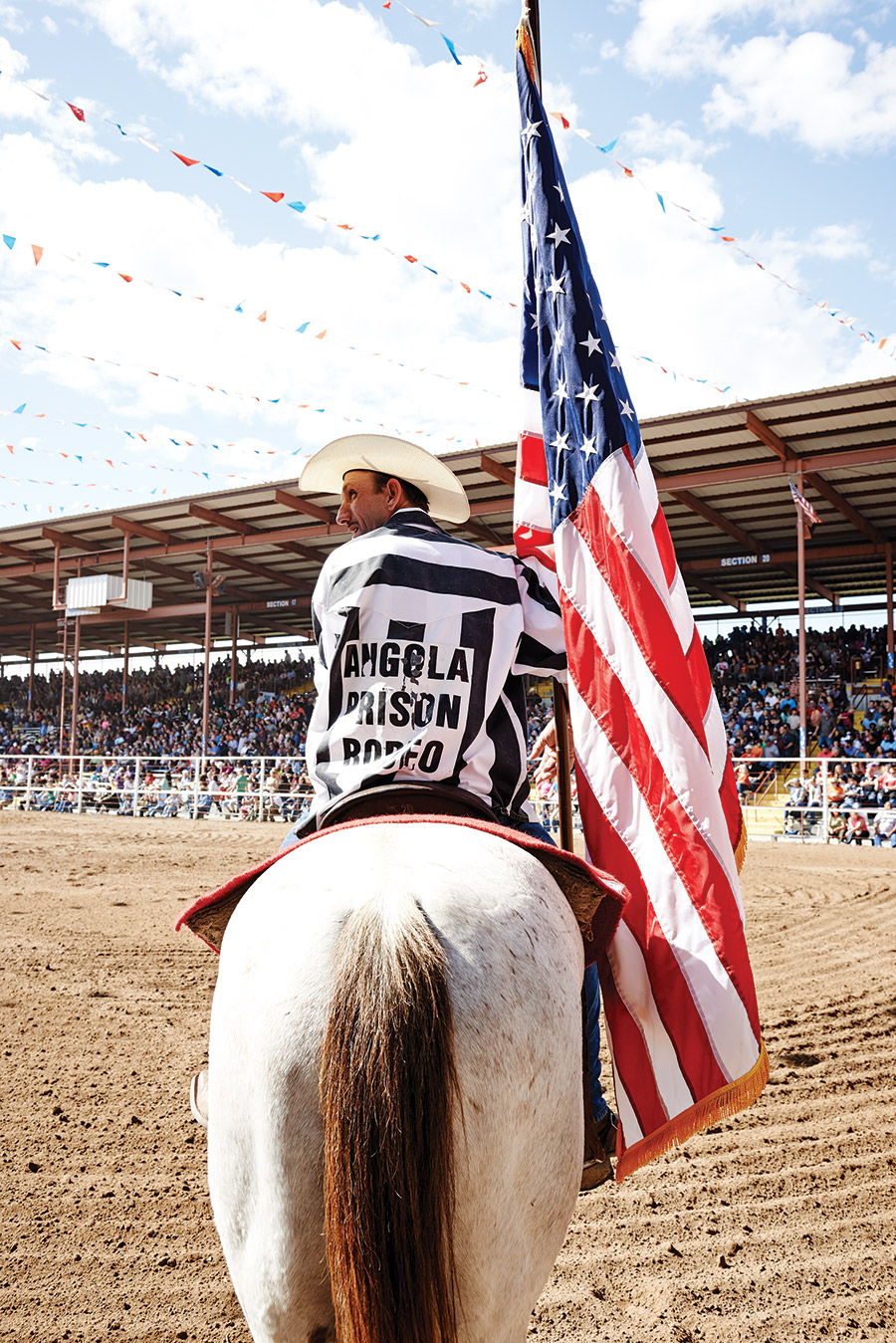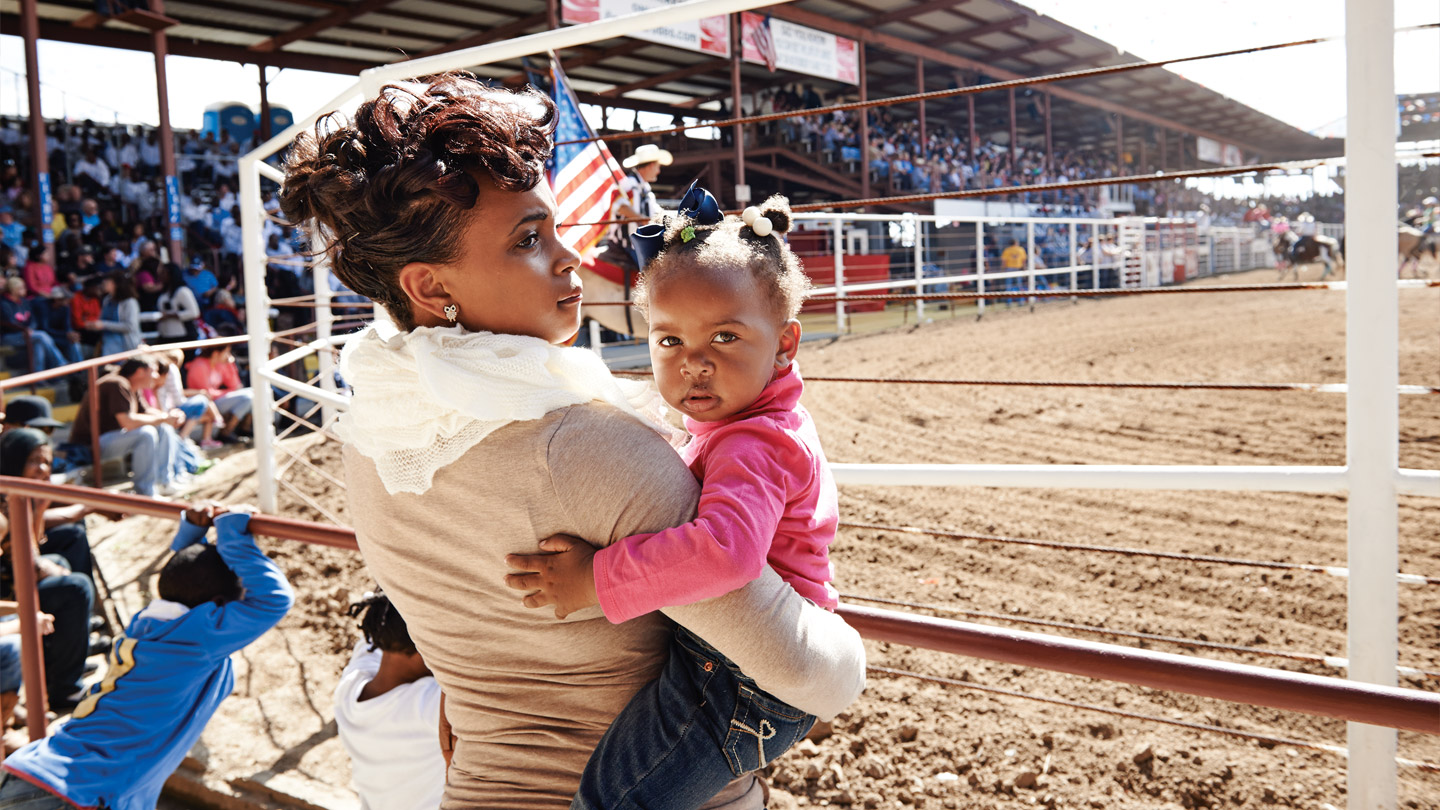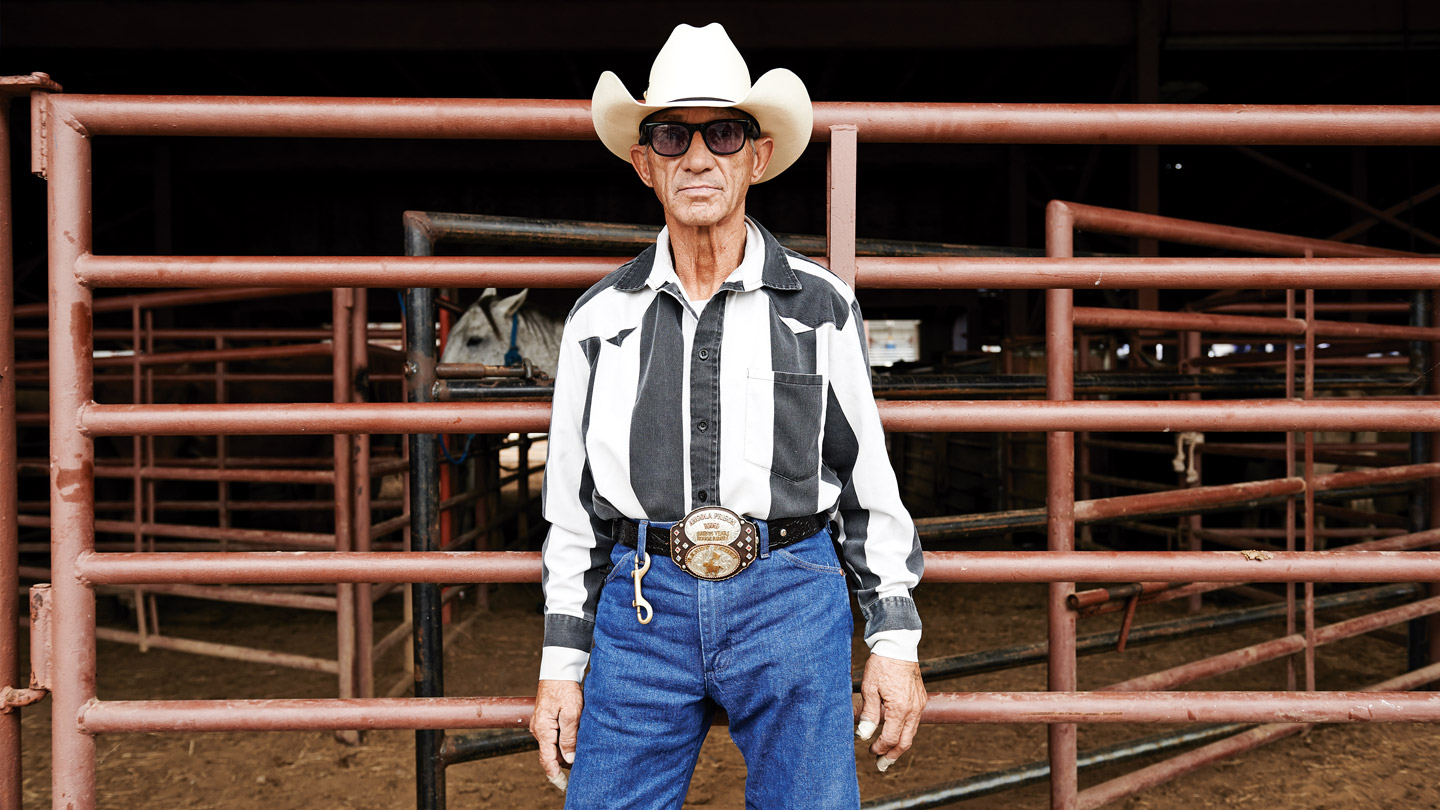At the northern edge of the rodeo grounds, within spitting distance of the perimeter fence, Marlon “Tank” Brown keeps warm in the 12ºC cold, bouncing from one foot to the other. He looks young for a man who’s been locked up 15 years, with a thick neck and sturdy, compact build that suggest he’d be hell to bring down in the secondary. He has the wide, triangular jawline of an earthmover, with a wispy patch of beard on his chin, and his hair is cropped short. A pristine silver and gold belt buckle glints at his waist. “That’s the Guts and Glory buckle, 2010,” he explains, a wide smile flashing from his mouth to the corners of his eyes. “I’ve been winnin’ it since 2009. I have so many of ’em, I just give ’em to dudes.”
It’s a typical Sunday morning in October at Louisiana State Penitentiary, also known as Angola, home of the longest continuously running prison rodeo in America. By mid-afternoon, about 14,000 members of the paying public will have followed the two-lane blacktop that cuts through the slash pine and live oak of the Tunica Hills and driven, kids and grandparents in tow, through the front gates of one of the most notorious maximum-security prisons on Earth. Spectators will spend much of the day talking, laughing and engaging in commerce with convicted murderers, rapists, thieves and drug dealers, and at the peak of the festivities, 100 or so of Angola’s gutsiest inmates will step into a ring with 1,800 pounds of pissed-off beef for a brief and life-threatening taste of freedom.
Rodeo season at Angola is a five-event affair, with a two-day kickoff the last weekend in April and one every Sunday in October. Guts and Glory, Tank’s bread and butter, is the climax of each rodeo day and Angola’s most famous event. Its premise is simple: A poker chip on a string is tied between the horns of a fighting bull, resting on its forehead. The bull, agitated by the chip and the crowd and bred to be hot-blooded, is released into the ring with 30 or 40 inmates. It treats them roughly as it would a china shop, and whoever comes away with the chip wins a cash prize — usually $500.
Serving a life sentence for murder, Tank has been competing in the rodeo since 2000 and has snatched the chip on 15 occasions, three shy of the all-time record. A country boy, he “came up rough… messin’ with alligators and snakes and all that type stuff,” and attributes part of his competitive advantage to the familiarity and comfort he feels having dangerous animals in close proximity. “If you get scared, you already defeated yourself,” he says. “I respect ’em, I know they can hurt me, but I ain’t scared.”
A skilled horseman, Tank is a member of the prison’s mounted drill team, the Angola Rough Riders, but doesn’t compete in any of the rodeo’s riding events in an effort to stay healthy for Guts and Glory. He moves continuously as he speaks, a measured two-step sway, and holds a T-shirt draped over the back of his neck with both hands, causing the muscles of his upper arms and chest to pop. He gives off a crackle of potential energy, not nervousness, but something ready and a bit impatient. “I just like messin’ with the animals, the thrill of it,” he says. “Knowin’ that [the bull is] aggressive, so I gotta be more aggressive than he is. I gotta be the dominant one. That’s how I look at it.”
While other competitors tend to wait for the bull to run itself down a bit and tire, Tank goes after the chip right out of the chute, willing to take a big hit early on. “I try not to take the contact if I don’t have to, but if I’m sure I can get that money, I don’t have no problem with him hittin’ me,” he says. “I’ve been knocked out twice dead, but I’ll shake it off and go back at him again. My motto is: If he don’t break nothing, he don’t stop me.”
Already in possession of the Guts and Glory record for fastest time, at 19 seconds, Tank plans to do more than just top Angola’s all-time win total. “They’re gonna have to work to get mine,” he says with a laugh. “Whenever I do try to set it down, I’m gonna make sure it’s up in the 20s.” Still, Guts and Glory holds a significance for him beyond the bragging rights it provides. “I’ve been locked up goin’ on 16 years, never sent home for money,” he says. “I send home to take care of my kids with the money I make. I don’t want for nothing but my freedom. I don’t want to put a burden on my people, I was always brought up independent. That’s why I do what I do.”

In addition to razor wire, iron bars and poured concrete, Louisiana State Penitentiary is made up of some truly staggering numbers. The prison sits on 18,000 acres of what the souvenir rodeo program describes as “the finest farmland in the South” — enough fine farmland to fill 83 per cent of Manhattan Island. It has its own public golf course (greens fees: $10) and zip code (70712). It employs 1,400 guards and has 1,483 cells, 6,300 inmates and an operating capacity of 6,380. Inmate labour keeps the place humming and runs as cheap as two cents an hour. The overall average sentence is 93 years, and 75 per cent of the inmate population is eligible to attend meetings of the Angola Lifers’ Association.
Angola is divided into a main prison complex and six out-camps, each bearing a letter (C, D, F, I and J) except death row, which holds 1.6 per cent of the facility’s offenders. A double fence surrounds each camp, but the prison as a whole has no perimeter wall. It’s bordered on three sides by the Mississippi River and on the fourth by a stretch of foreboding wilderness called the Tunica Hills. Hybrid wolf-dogs are released at night to roam the fields between camps, and everyone seems to agree that’s enough disincentive.
To run their maximum-security prison at near capacity, Angola’s staff have to be able to inspire hope and put a measure of trust in their charges. Begun as a source of in-house amusement in 1964 and opened for public consumption in ’67, the rodeo is crucial to that effort. The revenue it brings in supplies and maintains on-site trade schools and re-entry programs, pays inmate teachers and funds improvements to Angola’s infrastructure — and the opportunity to rub shoulders with people outside their usual social circle is something inmates look forward to year round.
Even more important is a caste system that divides prisoners into one of two categories: big stripers and trustees. In a rough sense, trustee status is a reward for 10 to 12 years of exemplary behaviour. Think of it as prison tenure. Trustees get perks denied big stripers and are eligible for jobs that require less supervision, chief among them — at least in the eyes of most rodeo participants — a spot tending cattle and horses, and mending fences on the range crew.

On this Sunday, both trustees and big stripers are represented on the list of rodeo participants, and both are out selling their hobby crafts on the grounds, but only the trustees are free to move among and interact with the crowd. Big stripers interested in selling crafts do so locked in a U-shaped pen to the north of the main arena, conducting what business they can through the fence — by far the day’s most overt security measure. Those participating in the rodeo itself are searched and escorted across the grounds by a pack of guards, and made to wait for the show’s 2 p.m. kickoff under lock and key in a reserved section of the grandstands.
The main gates open at 9 a.m., and the crowd is already thick half an hour later. Traditional breakfast food is hard to come by, but the rodeo seems to attract the iron-stomached. Smoke is already pouring from stands selling chicken-on-a-stick, and a woman in a pink T-shirt with the slogan “Oil field honey, spending oil field money” airbrushed across the back is handing a little boy what one hopes is his first fried Coke of the day.
Past the pony rides and an entire tent dedicated to an excitable bloodhound puppy, the Lifers’ Association has a stall with caramel corn on offer for three dollars a bag. Beside the carousel, a longhorn steer with soft, ash-coloured fur is available for pictures. A live gospel band belts out praise songs. Customers haggle over the prices of gun racks, plants, picnic tables, decorative leather belts and stained-glass jewelry boxes. Toddlers throw french fries and issue incomprehensible demands.
To the west, the main rodeo arena rises, all rust-coloured girders and dull-grey concrete. A fleet of livestock trailers occupies a small field at its southern tip, and a young barrel racer runs her horse in circles at their centre. Watchtowers poke up here and there, to all appearances unmanned, among the food and craft stalls, and a 15-foot-high galvanized fence, topped by two looping rows of razor wire, surrounds everything and marks the outer limit of the grounds. The combined effect is much closer to county fair than county lockup.
Twenty minutes before the rodeo is slated to begin, the clouds finally blow over and the sun comes out, bathing the groomed brown dirt of the ring in light and upping the temperature about 10 degrees. The main arena is packed. Spectators stand in the aisles and squeeze under the metal guardrail meant to keep them back from the white steel-cable fence that surrounds the ring. Bowlegged old men in cowboy hats ease themselves down onto their concrete seats. Strings of red, white and blue flags stretching from the grandstands’ corrugated roof whip and flutter in the wind. Rodeo announcer Mike Mathis captures the mood nicely: “It’s Sunday. The sun is shining. The Saints are winning. Ladies and gentlemen, you can’t do better than that.”
The Rough Riders fly into the arena at full gallop, screaming the length of the ring two abreast, flags snapping behind them. Led by Randy Ledet, a lifer on a sand-coloured horse, they split before the fence and peel back, each man settling his mount into position around the edge of the ring. With the Rough Riders in place, the prison honour guard marches in from the chute carrying the American flag. The “greatest country on Earth” is praised at length, with a heavy emphasis on all the freedom it provides, and a man named Roosevelt Joseph, stripped of that freedom and dressed in the black-and-white-striped shirt worn by all the rodeo’s inmate participants, pulls “The Star-Spangled Banner” from somewhere deep down in his belly and thunders it out over the PA.

The roar Joseph leaves in his wake is silenced by the first three sobering notes of “Taps.” A riderless black horse named Little Man is paraded through the ring and Mathis delivers a eulogy to its former owner, a recently deceased Chevrolet dealer and “friend of the rodeo” by the name of Gerry Lane. When Lane and America have been sufficiently feted, a lengthy list of sponsors recounted and VIPs in attendance — including Sheriff J. Austin Daniel and Shreveport Senator Gregory Tarver — noted, the ring is cleared, and professional bullfighters begin prepping a handful of inmates for the day’s first event: Bust Out.
As a form of entertainment, Bust Out scratches the same itch as dropping an old TV out a second-storey window. Eight bull-riding bulls are loaded into the ring’s eight chutes, and an inmate in a black protective vest, helmet and full-face shield takes a seat on each one. The start is signalled, the chutes open, and the bulls are released. All eight of them. At the same time. The winner is the man who hangs on the longest.
When the chutes open, it’s difficult to decide where to focus your attention. Dirt, horns and limbs fly everywhere. One rider is thrown over his mount’s shoulders on the first buck. He lands hard in the dirt beside its front legs and is trampled by both his bull and the one next to it before they kick him clear and bolt for the centre of the ring. Every inmate is thrown within five feet of the chute, and the whole event lasts about four seconds. Miraculously, the participants all limp for the fence under their own power. Blake Rodriguez is announced as the winner, and the next several minutes are spent manoeuvring the bulls out of the ring while the crowd struggles to absorb what they’ve just witnessed.
Many of the day’s events proceed along those same lines: A setup that renders its participants almost comically doomed from the jump, several seconds of bucking, trampling and light goring, and a winner determined as much by luck and the indecipherable whims of an 1,800-pound animal as anything else. Convict Poker sees four inmates seated around a card table for as long as they dare while a bull is turned loose and coaxed into charging them. In today’s incarnation, the unlucky soul sitting with his back to the chute is hit from behind and speared clean through the table. “If you’re looking for a quality horse ride, bareback ride or a quality bull ride, that ain’t gonna happen here, because [the inmates] don’t ever get to practice and they don’t know what’s goin’ on,” says former professional bull rider Bubba Dunn, the man hired to supply all the rodeo’s fighting and bucking animals. “But you’ll see they’ll apply all the effort that they know to apply. They’re gonna try. They want to be centre stage and do something great.”

Two hours before the rodeo, Dunn’s contractors are busy equipping and situating the day’s bovine and equine performers in a series of connected pens beneath the grandstands — 10 experienced bullfighters already engaged in the delicate process of tying on the chip for Guts and Glory. Contrary to all available sensory evidence, the ideal animal for Guts and Glory is not the nastiest at hand, according to Dunn. “You don’t want him real mean to where he just goes out there and targets one guy,” he explains, spitting a thin line of dip from the side of his mouth, “because it gives a freebie for 10 more to go in and get [the chip] while he’s got his head down. You want him a little wild and scattering around, so they have to run a bit and he’ll hook ’em as he goes through ’em.”
On a nearby table, a guard drops two pairs of spurs confiscated from a group of big striper participants just brought in from Camp D. One pair looks store-bought, the other like it was made by hand in a prison tool and dye shop. Both had been “locked up,” rigged to prevent them from spinning, allowing their wearers to dig them into the sides of their mounts for better grip. “Free-runnin’ spurs or none at all,” the guard announces, taking a seat at the table. His judgment draws quiet nods of affirmation from everyone around.
While the contractors continue to ready their stock, Timothy Gay, a wiry big striper in a thin, grey sweatshirt and blue jeans, serving a life sentence for armed robbery, stands on the opposite side of the pens, looking in at a group of 10 bulls. His dark-brown eyes move over a slate-grey animal with an imposing hump of muscle above its shoulders, and a white one with what looks like spatters of black paint all up its sides, and come to rest on a cream-coloured bull with long, curving white horns, tucked against the back of the pen. “I really want that one over there,” he says, pointing, “but he’s kinda smart. He lays on the side of the chute so you can’t get your right leg down. But he’s a good bull.”
Gay’s intel is impressive given that the inmates only ever interact with the animals in the main arena on rodeo day. To add even more spice to the proceedings, Dunn and his employees regularly switch up the bulls, meaning rodeo participants often fail to find a single familiar face beneath the sea of horns. “When the bulls come up, we’ll come over here and look at ’em and try to let everybody know what he did with us so they can expect that,” Gay explains. “Last Sunday, the white one there came out and, all of a sudden, he just went in a spin. He’d never done that before. He usually comes out and just bucks real hard.”

Coming into today’s rodeo, the last of Angola’s 49th season, not one inmate had turned in a successful bull ride (one that lasts at least six seconds). Gay was the only inmate to do it last year and, along with some good bareback riding, it earned him 2012’s All-Around Cowboy. As he turns from the pen, a belt buckle announcing him as such catches the light.
Gay is in the running again this season. Winning the all-around can help an inmate land trustee status, he explained, something he’s still waiting on. He also hopes a second straight title might help him land a job with Tank on the range crew, because he likes being around horses, part of the reason he started rodeoing in the first place. “But for me, really, it’s just being out here,” he says, gesturing at the ring and the concrete grandstands. “Despite me being in prison, it’s like I ain’t even here no more. For that moment, it just feels good. To see people coming in and watching… it shows me one thing: That they be thinkin’ about us. I like that. Even though we’re in prison, we’re not forgotten.”
Against all odds, the afternoon does feature a few presentable bareback rides, but Gay’s quest for a second-straight All-Around Cowboy title takes a hit when his horse refuses to leave the chute. Hunkering down and wedging its front hooves against the wall of the pen, it resists a few firm shoves from Dunn’s contractors and stays in place long enough that they close the gate to properly address the issue. The bit starts to feel almost scripted when the chute door opens a second time and, instead of taking off, Gay’s mount settles down even further, doubling 90 per cent of the crowd over in red-faced paroxysms. When it finally does bolt, spinning and kicking wildly, Gay is caught off guard and thrown almost instantly. He rises from the dirt and slaps his knees in frustration before walking back to the fence and hauling himself out of the ring.
Though every event save one — women’s barrel racing — is 100 per cent inmate performed, prisoners aren’t the sole source of entertainment. After three white-throated capuchin monkeys, dressed in sequined cowboy costumes and riding border collies, herd a pair of mountain goats onto the back of a truck, their owner, Tim “Wild Thang” Lepard, gives a speech encouraging the children in the audience to believe in themselves. It begins: “In 1962, a boy was born in Memphis, Tennessee, and his dream was to own a monkey.” Three guesses as to who the boy was and how the story ends. Lepard and his dream capuchins are outdone by a second specialty act run by a red-vested Oklahoman named John Payne. Mathis explains that “an industrial accident cost [Payne] his arm many years ago,” and with “Bad to the Bone” blasting out of the arena’s loudspeakers, the “One-Armed Bandit” drives a pair of 2,000–pound American buffaloes onto the roof of a horse trailer using only a bullwhip. Through all of this surreal spectacle, Marlon “Tank” Brown waits, ready and a bit impatient, at the side of the ring for the final event of the day. His event. Guts and Glory.

The bull has already shrugged itself free of the chute and made a first arcing pass at the group of men gathered against the fence on the opposite side of the ring when it slows, spins and gives Tank its full attention for the first time. Its horns are spray-painted red above a wide, white face and dull black flanks, corded with muscle, and sunlight lances through the dust rising at its feet. Tank wears loose-fitting jeans and a neon-green bucket hat meant to help distinguish him from the crowd. He hikes the jeans up his thighs and drops into a defensive stance, his head about even with the bull’s shoulders.
It closes in on him, sucking all noise from the arena. He backpedals slightly then lunges forward, swiping at the chip with his right hand. The animal’s head hooks violently, and Tank dodges back onto his left leg and lunges a second time. He misses the chip and is caught by a horn and knocked to the dirt, but comes back up unharmed as the bull pulls away from him. The lack of catastrophic injury through the first 10 seconds seems to relax the crowd a bit, and there’s a smattering of applause as Tank takes off, sprinting after the bull.
When it again slows and spins, thick lines of spit falling from its mouth, Tank is the first to meet it. This time, it doesn’t hesitate, ducking its head and charging him. A wave of involuntary screams rushes from the grandstands. Tank keeps his hands up, reaching for the wide, white forehead. He misses the chip. The bull slams his arms back into his body and drives him into the ground, then continues over him, breaking for the fence, scattering inmates.
Tank finds his feet and again sets off after it, pushing competitors aside and angling to cut it off as it follows the fence around the perimeter of the ring. There’s a buzz and an added urgency in the air, the crowd sensing both the bull tiring and the inmates’ resolve hardening. When Tank works his way back in front of it, a tightly packed group of about 10 men is alongside him. One grabs at the chip. The bull jerks its head, but doesn’t run. The circle around it tightens and all hell breaks loose.

Arms dart in from every direction. The bull bucks wildly, its front legs leaving the ground. Dust sprays up in a thickening cloud. Inmates press in. Tank’s hat is visible above the scrum, and then it isn’t. It reappears in the dirt, still on his head. He lies face down, limp and unmoving. The bull swings its head above him, bringing two more men crashing down on his back. There’s just enough time to get out an “Oh, sh—” before the bull runs them over, trampling all three as it races for the fence. It turns. Its forehead is bare, the chip gone. “Somebody’s got it,” Mathis yells. A buzzer sounds. No one seems to know who has the chip. Two inmates lean over Tank. They help him up onto his knees and then carry him from the ring as the winner bolts into the open with the chip raised in the air.
At any other sporting event, a participant being knocked unconscious would necessitate a stop in play, maybe even a stretcher. At Angola, it doesn’t prompt acknowledgement of any kind. A minute after Tank is lifted from the ring, a second Guts and Glory bull is released, and the whole scene plays out all over again. There’s no denying that lends the proceedings an air of the gladiator’s arena, but these men, denied the most basic choices since they made the one that landed them here, have chosen this—for the thrill, the independence, the connection, the glory and, even if only for a few seconds, the freedom.
This story was originally published in the Dec. 2, 2013 issue of Sportsnet magazine.





